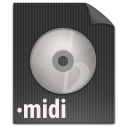Trojan Asteroid Jungle - Touhou Arrange - R.H only
- Author
- NoOneLaysHere
- Type
- Grand Illusions 30
- Created
- 17/08/2017 23:05
- BPM
- 102
- Length
- 1568
Transcribed onto a 30-notes music-box, and transposed, such that B becomes E, G becomes C, etc.. This transcription follows more closely to an arrangement by akikiki than the original.
There's a lot of staccatos throughout the arrangement, but the nature of a music-box (or a simple one at least) prevents the ability to properly perform staccatos.
* At the end, there's a ritardando. If playing with a physical music-box, slow the piece down gradually until at half tempo at the end (last five measures—for reference, the R.H. near the end is playing whole notes).
Only the melody part is transcribed.
Hole punch paper strips Export
Yay! It looks like this melody can be played offline on a 30 note paper strip music box!
All you need to do is:
- Get a 30 note DIY Music Box Kit from our online store page if you don't have one
- Export the melody to PDF with paper strips, print it out and cut with scissors. Make sure to use the right paper size and set you printer scale to 100%, otherwise the size won't match. It's better when paper strips are thick, so if you are going to use thin office paper, we recommend you to glue two or three layers together. Another option is to laminate paper strips with a transparent duct tape
- Punch holes with a tool from the music box kit
- Enjoy your favorite melody playing on a real music box!
Grand Illusions 30 music boxes More
Similar melodies
Transcribed onto a 30-notes music-box, and transposed, such that B becomes E, G becomes C, etc.. This transcription follows more closely to an arrangement by akikiki than the original. The notes played with the L.H. are raised by an octave. The last note for the L.H. part is raised instead by two octaves (, else it'd be a G1 instead of G3). Another exception is in the area where the stripe (the "measure") is numbered as 123 to 138 (where length is approx. 977 to 1104), inclusive. In this area, the L.H. is not raised by an octave, i.e. it plays at the original relative pitch to the R.H., by the arrangement. There's a lot of staccatos throughout the arrangement, but the nature of a music-box (or a simple one at least) prevents the ability to properly perform staccatos. * At the end, there's a ritardando. If playing with a physical music-box, slow the piece down gradually until at half tempo at the end, the last five measures (technically seven, but the last two measures are empty–those two are omitted here)—for reference, the R.H. near the end is playing whole notes.










Comments Subscribe